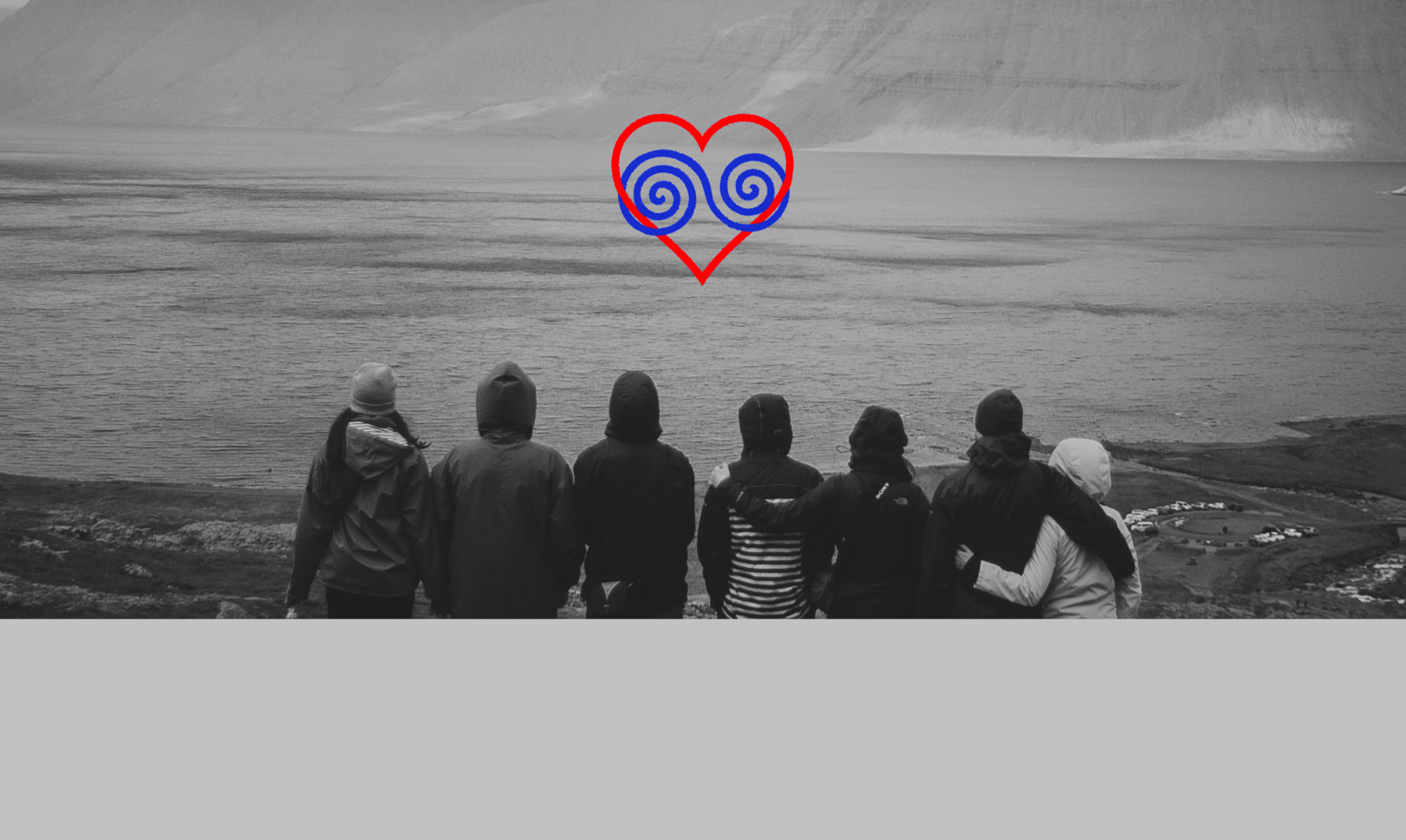…though the blessing comes from higher.

If Oligoamory were a tree, it would have different “roots”.
The main root is definitely Polyamory, of which my “Oligo-Amory” is effectively an offshoot.
Polyamory, as a manifestation of Non-monogamy, offers a concept in which non-exclusive loving relationships with more than just one other person are feasible in a committed way.
Thus, “Non-monogamy” is virtually also one of the roots of Oligoamory, if only because it allows the freedom of thought to indulge in a quest for more than one intimate relationship in life.
Polyamory, on its part, which distinguishes itself in the large group of non-monogamous relationships with the addition of the phrase “ethical multiple relationships,” wants to work toward ensuring that such multiple relationships are established responsibly, consensually, and transparently – that is, with the greatest possible (equal) entitlement – and, above all, with the knowledge and consent of all involved.
So all the values that apply in this respect to Polyamory are in any case also applicable to Oligoamory.
Another important “root” of Oligoamory is the community-building process as described primarily by the U.S. psychiatrist and author Scott Peck¹ – and which has become fundamental to many forms of communal living, such as ecovillages, housing projects, and shared-living communities. At the core of community building lies a very inclusive and integrative way of thinking, which significantly aims at a “common wholeness” with a “we-feeling” at its centre. Describing it as a “process” is here the intended reminder that there will never be a “final” or “finished” state in this form of togetherness, but rather that it is an approach that will be continually revisited by those involved to be further adapted and configured according to current developments.
However, the oligoamory would not be the “Oligo”-Amory (with the prefix “oligo-“, which comes from the ancient Greek word ὀλίγος olígos “few”), if it would not suggest a way of living and loving, which would rather aim at a manageable number of participants. And in this quality there are roots in Oligoamory, which, among other things, arise from requirements connected to the phenomenon of Sensory Processing Sensitivity (SPS), as it has been defined by the U.S. psychologist Elaine Aron.
Since I, as the author of this bLog, consider myself as being affected by SPS, I have realized for myself that a high level of care with regard to the quality (before quantity!) of my social relationships is extremely beneficial to the nature and relevance of these relationships, especially in terms of coherence, predictability and intimacy.
Since I am therefore personally very strongly confronted via SPS with the manifold shades, facets and nuances of the surrounding world and my entire existence – which for their part rarely submit to pure classification of “either…or” – I was, apart from Polyamory, also fascinated by the approach of “Relationship Anarchy“, which has thus also become a root of Oligoamory.
This philosophy of relationships, first proposed by the Swedish journalist Andie Nordgren, rejects artificial or socially exclusive categories for describing interpersonal relationships.
Whether another human person is my best friend, my beloved, my companion, my acquaintance, my favourite person, my partner or whatever – according to the approach of Relationship Anarchy, this is solely a matter of agreement between the parties involved in the respective relationship. Likewise, it is merely a matter of agreement between those involved “what” – so to speak “which content” – constitutes the actual substance of this individual relationship. Be it platonic friendship, the dedication to a connecting hobby or some other commitment, spiritual kinship, sharing a common daily routine, a weekend relationship, sexuality, all of these together, or whatever mixture of completely other characteristics – all of this represents a range of possibilities that is difficult to grasp with a concrete term, but would rather have to be described by the participants themselves if they were asked what kind of nature their relationship to each other would be.
Thus, it is also part of relationship anarchy (keyword “loving free of domination”) that due to the open negotiability, which exclusively concerns the participants of the relationship, no external rules or boundaries may be applied, which e.g. would predetermine what might be possible and/or socially acceptable “only” between friends, “solely” between lovers, or “exclusively” between intimate mates.
Exactly this categorylessness and freedom of agreement are also part of Oligoamory, which in this aspect connects well with the nonconformist and queer heritage of Polyamory (see Entry 50).
When I describe my Oligoamory, two other essential roots usually come to my mind:
On the one hand, this is romanticism. I have already outlined in Entry 34 that I consider the so-called (and as a topos of fictional narration almost archetypal) “self-sacrifice” to be a core motif of Romanticism. However, what sometimes comes across so dramatically in myths, novels and narratives, has in my view a very tangible, everyday manifestation in Oligoamory: The willingness to go the famous “extra yard” beyond one’s own “sphere of ambition” for the other parties involved in a relationship. Surely, at this point we also recognize in it Scott Peck’s community-building process, wherein without such altruistic thinking, a “mutual we” would never be achievable.
At the same time, to my opinion, there also lies a share of what the humanistic psychologists Carl Rogers and Abraham Maslow called “self-actualization”. I sometimes somewhat humorously call this aspect “comfort-zone-stretching”.
Especially in our closest interpersonal relationships – those of a familial nature, but also those of a “self-chosen” nature – we are most regularly confronted with what the Canadian psychologist (and father of social-cognitive learning theory) Albert Bandura called “self-efficacy expectation“. And by that I mean all those situations where we are confronted with circumstances, motivations, feelings and actions where we involuntarily ask ourselves “Can I do this?” – and where we have to face what ensues. The natural reflex of our weaker self would usually be to turn our backs on such challenges, to turn a “No, (maybe) I can’t do that…” into a “No, I don’t want to do that!” and in this way to stay safely within our comfort zone. But with that we would have taken away the chance for further ” self-actualization” ourselves.
However, every time our closest fellow human beings, friends, loved ones, companions, acquaintances, favourite people and partners were worth it to us to leave our comfort zone under the conviction “I can do that (after all)!”, we ourselves have become a bit more self-effective – and thus at the same time a little bit more “an even better version of ourselves”.
So when the romantic narrative says that there is a hero*ine treading the “path of the greatest possible courage”, that is above all what is meant by it: for the sake of others, we grow in ourselves. It almost can’ t get any more romantic than that in Oligoamory…
On the other hand, it remains for me to list “idealism“, and idealism – okay, that was to be expected – certainly also goes hand in hand with romanticism. Even the German Wikipedia says that “in everyday language idealism denotes, for example, an altruistic, selfless attitude”. But the same Wikipedia also suggests that idealism “emphasizes that reality is radically determined by cognition and thought” (and who would I be to disagree as a relationship philosopher…!).
When I speak of idealism with regard to oligoamory, I mean here mainly the aspect unsurpassably expressed by the Czech playwright, essayist, human rights activist, and politician Václav Havel in his words »Hope is not the conviction that something will turn out well, but the certainty that something has meaning, no matter how it turns out.« [first quoted in Entry 61]
For if the psychiatrist Scott Peck is right (and in all likelihood he is) that our human relationships are never finished entities but open, organically evolving processes to be revisited throughout the duration of their existence, then by their very nature they defy any performance evaluation of “good” or “bad”. And should we as participants try to submit to such a dictate of performance criteria in our relationship design, then we would hardly get anywhere in our good Maslowian self-realization and self-efficacy.
Idealism, however, poses (as Wikipedia states) the question of possible meaning and cognition. And Václav Havel assures us that this is also very well possible within processes, even if they do not have an “end” in a classical sense of performance. Rather, with Albert Bandura, he encourages us to continually align our motivations, feelings, and actions with our values and beliefs in such a way that they serve us as a kind of guiding star to draw us out of our comfort zone: “I can do this!”.
Bandura’s social cognitive learning theory thus promises us – especially with regard to those of us who aspire multiple relationships – that our self-esteem will grow the more social roles we trust ourselves to assume. Yes, even more: since “self-esteem” means “being valuable ourselves”, we regularly “feel valuable” through those social roles in our relationships.
So today I have once again outlined the main roots of Oligoamory. And in the run-up to this article, I thought about them and realized that for me, yet another component is still missing.
Since now, I would be able to imagine the perfect oligoamorous relationship: It would be polyamorous at its core, in a continuous community-building process, it would feature quality- and self-care in the sense of SPS, it would be category-free and both romantic-altruistic as well as self-actualizing-idealistic.
If all this were given, I too would say that this would definitely describe a good (multiple) relationship – and yet…
As I sit here today, I wish you to have one more ingredient to those described above, which I would like to call today simply and unspecifically “spirituality“.
“Spirituality”, says the German Wikipedia, “is the search for, the turning toward, the immediate contemplation or subjective experience of a transcendent reality that cannot be sensually grasped or rationally explained and which is beyond the material world.”. Wikipedia further names as components of spirituality “questions of meaning and values”, “experiences of the wholeness of the world” as well as “connectedness with one’s own existence”.
And I think without these last three impulses we still could have a quite perfect relationship by oligoamorous standards – but our hearts might remain a bit clammy in it.
Perhaps in my case this is because I do not consider purely reason-based ethics to be sufficient as a sole basis for me.
Perhaps it is because I state for myself that at present I still exist in a world in which science has by no means found a conclusive answer to all questions, but in which even the cleverest minds confirm with awe in their eyes that every context that has just been satisfactorily answered instantly carries a merry bunch of further and deeper questions in its wake…
Probably, however, I feel the same way as Friedrich Schiller did regarding his “Lied von der Glocke” (Song of the Bell²), of which one line provided me with my title for this Entry. And in this respect, it will probably come as no surprise that the most essential components of Oligoamory stem from, of all people, a neopagan author (Entry 49) and a Christian community coach (Entry 8, among others):
Every day, we fearlessly tread the “path of the greatest possible courage” once again, undauntedly stretching the measure of our self-efficacy; we regularly exceed the limits of our own comfort for the people who are important to us; we don’t ask, when it matters and someone is crying at our front door at night, whether somebody is a loved one, a friend or “just” a neighbour; sensitively, and regardless of this, we try to improve the quality of our relationships; we prove ourselves to be part of a community and we sincerely strive for genuine loving relationships and in this we do not want to be limited to just one person…
But the “blessing”, the “meaning” – and indeed “no matter how it turns out” – in all these things will be something that is “greater than us”, something that “exceeds us”.
And this is where multiple relationships, in fact, successful human relationships as a whole, become something truly wonderful for me.
For that which is “greater than us”, that which “exceeds us” is called in spirituality precisely “transcendent“ (from Latin transcendere “to overcome/exceed”). It is that which I have described from the first hour of Oligoamory as the element that produces “more than the sum of the parts” – which is the result of the interaction of all those involved, and which produces the added value from which (hopefully) everyone benefits.
But in order for this meaning, this added value to emerge, we call up something in each of us that makes each of us unique, precisely that inalienable self-worth that makes each of us “us” and without which the unique composition of ingredients in a relationship would not work. And exactly this something which is contained in things and living beings, which results from their individual and objective existence, is called “immanent“ (from Latin immanere, ‘to remain in’, ‘to adhere to’) in spirituality.
How does it say again in Schiller’s “Song of the Bell”: »…That the work may praise the Master, Though the blessing comes from higher.«? As far as I am concerned, the great poet and thinker could also have written »…from within«. Because we consequently need both, immanence for transcendence and transcendence in immanence; both emerge from each other – and neither of the two phenomena can exist without the other (at least in Oligoamory).
This is as close as we can get to what many religions call divinity in our yearning, striving and acting – for ourselves and in our relationships.
That kind of divinity that already dwells in all of us and is only waiting to be allowed to emerge more and more, layer by layer.
And that certainly has meaning in any case.
No matter how it turns out.
¹ Primarily set down in: Scott Peck “A Different Drum”, 1984
² Links to possible translations:
http://friedrichschiller.weebly.com/song-of-the-bell.html
https://www.bartleby.com/177/46.html
Thanks to Ashwini Chaudhary on Unsplash for the photo!

